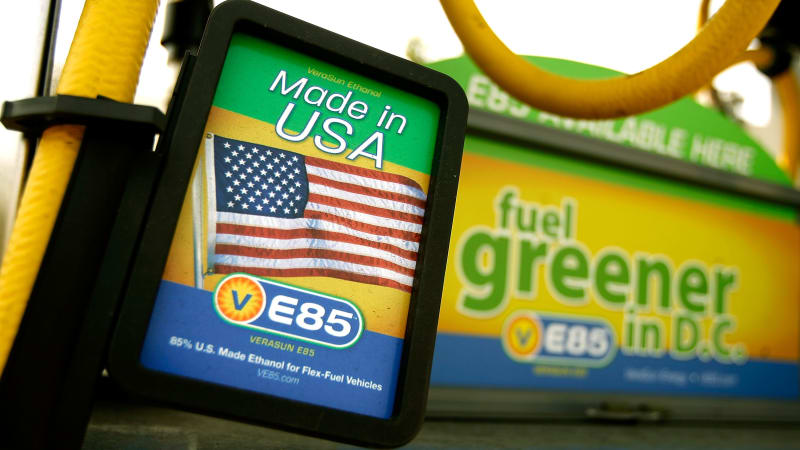On the surface, Flex Fuel sounds like a great idea. Certain cars designed for this can run on different blends of gasoline and ethanol. Okay, we all know gasoline, but then what is ethanol? This is a type of alcohol that is obtained from crops such as corn or sugar cane. Ethanol fuel emerged in response to oil shortages beginning in the 1970s and eventually became an important market for grain farmers. It wasn’t until the 1990s that flex-fuel engine technology really matured and automakers, particularly the Big Three, began introducing flexible-fuel vehicles.
What is Flex Fuel?
Specially equipped vehicles labeled as flex-fuel capable can run on E85, a blend that can contain 51% to 83% ethanol and just the rest as gasoline. However, to a lesser extent, almost all modern cars already use a gasoline-ethanol mixture. Most gasoline sold at pumps in the United States could technically be E10, a 10 percent ethanol blend, although this is not always the case.
The EPA has also approved E15, a 15 percent ethanol blend. However, in 2012, a coalition of automakers rejected a proposal to increase ethanol content by 50%. The EPA considers the use of E15 safe in 2001 and newer vehicles, but there is conflicting research as to whether it is harmful or not. Many automakers said at the time that they would not honor warranties if owners used E15.
Flex Fuel Pros
By expanding the amount of gasoline actually consumed, Flex Fuel appears to be the perfect solution to expand a finite resource and reduce dependence on foreign oil. And since the ethanol was made from renewable biomass, it was originally considered an environmentally friendly solution.
Additionally, E85 has an octane rating of about 110, which is higher than the 93 octane of premium fuel. This means the fuel is better able to withstand combustion through compression sooner than expected and therefore burns more completely, and cleaner combustion means fewer emissions at the tailpipe. While high-performance engines typically have higher compression ratios, current E85-compatible vehicles aren’t exactly sports machines that can benefit from the higher octane rating.
Because flex fuels use less petroleum, they are cheaper. At the time of writing, the national average for E85 is about 80 cents lower than E10, the most common type of fuel. Prices vary depending on the region. So check your local offers.
Disadvantages of Flex Fuel
If you have a flex fuel vehicle in times of high gas prices, using E85 might seem like a no-brainer. However, it should be noted that ethanol reduces fuel consumption (miles per gallon) by up to 25% to 30%. Depending on the vehicle’s fuel economy and the local E85 price, drivers must decide for themselves whether the reduced fuel consumption offsets any potential savings at the pump.
Perhaps an even bigger problem is that E85 may not even be as good for the environment as its proponents claim. In the United States, most ethanol is made from corn, and the corn industry has an extremely powerful lobby. Gas stations in states like Iowa, where corn is a major industry, are stocking far more E85, often with stickers touting its supposed environmental benefits.
Over the years, powerful corn lobbyists have received many government subsidies, which in turn has encouraged many producers to grow the crop, even though, according to a Stanford University study, corn-based ethanol production is five to six times less efficient than sugarcane-based ethanol .
Another study in the Proceedings of the National Academy of Sciences found that the environment would be better off if cars burned only pure gasoline, considering the increasing clearing of land to grow corn for ethanol production. And then there’s the fact that it would be better for us to use the resources that corn uses to grow crops that actually feed people. Ethanol would be most beneficial if it could be produced economically from biomass that would otherwise be thrown away, such as corn stalks and other cellulosic sources.
How to identify a flex fuel vehicle
Flex fuel vehicles are identified by either a yellow fuel cap or a yellow ring for capless fuel tanks. There may also be stickers on the inside of the fuel filler flaps or a special Flex Fuel emblem on the vehicle. The U.S. Department of Energy provides a list of flex fuel vehicles currently for sale. Most are workhorses like the Chevy Silverado/GMC Sierra, Ford Transit Connect, Transit, F-150 and F-250. The Ford Explorer is currently the only standard family car on the list, although you can find some older, discontinued flex-fuel cars on the used market like the Chevy Impala and Ford Taurus.
Should I use Flex Fuel?
If your vehicle was not built as a flex fuel vehicle, do not use E85. The high ethanol content damages important engine parts and the fuel system. As mentioned above, if you have an older vehicle or aren’t sure if it’s compatible in your car, it’s probably best not to risk using E15.
Does ethanol harm cars?
Many sources, including Britain’s Royal Automobile Club, say that even E10 can be harmful to cars older than the 2002 model year. Ethanol is corrosive and its use can damage fuel systems that are not designed to handle anything other than pure unleaded gasoline. Fuel tanks, seals and other rubber or plastic components can be damaged.
This is not a guarantee of damage, and how vulnerable your vehicle is will likely depend on its age and model. If this is a problem for classic car owners, they can either use an ethanol conditioner and stabilizer or visit one of the few remaining gas stations that offer ethanol-free fuel.
Finally, ethanol-containing gasoline blends are widely viewed in the boating industry as potentially harmful to outboard engines, particularly two-stroke engines.
Similar video:
